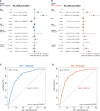Blood Hemoglobin Substantially Modulates the Impact of Gender, Morbid Obesity, and Hyperglycemia on COVID-19 Death Risk: A Multicenter Study in Italy and Spain
- PMID: 34795637
- PMCID: PMC8593102
- DOI: 10.3389/fendo.2021.741248
Blood Hemoglobin Substantially Modulates the Impact of Gender, Morbid Obesity, and Hyperglycemia on COVID-19 Death Risk: A Multicenter Study in Italy and Spain
Abstract
Background: Hyperglycemia and obesity are associated with a worse prognosis in subjects with COVID-19 independently. Their interaction as well as the potential modulating effects of additional confounding factors is poorly known. Therefore, we aimed to identify and evaluate confounding factors affecting the prognostic value of obesity and hyperglycemia in relation to mortality and admission to the intensive care unit (ICU) due to COVID-19.
Methods: Consecutive patients admitted in two Hospitals from Italy (Bologna and Rome) and three from Spain (Barcelona and Girona) as well as subjects from Primary Health Care centers. Mortality from COVID-19 and risk for ICU admission were evaluated using logistic regression analyses and machine learning (ML) algorithms.
Results: As expected, among 3,065 consecutive patients, both obesity and hyperglycemia were independent predictors of ICU admission. A ML variable selection strategy confirmed these results and identified hyperglycemia, blood hemoglobin and serum bilirubin associated with increased mortality risk. In subjects with blood hemoglobin levels above the median, hyperglycemic and morbidly obese subjects had increased mortality risk than normoglycemic individuals or non-obese subjects. However, no differences were observed among individuals with hemoglobin levels below the median. This was particularly evident in men: those with severe hyperglycemia and hemoglobin concentrations above the median had 30 times increased mortality risk compared with men without hyperglycemia. Importantly, the protective effect of female sex was lost in subjects with increased hemoglobin levels.
Conclusions: Blood hemoglobin substantially modulates the influence of hyperglycemia on increased mortality risk in patients with COVID-19. Monitoring hemoglobin concentrations seem of utmost importance in the clinical settings to help clinicians in the identification of patients at increased death risk.
Keywords: COVID-19; epidemiology; hemoglobin; hyperglycemia; machine learning; mortality; obesity.
Copyright © 2021 Mayneris-Perxachs, Russo, Ramos, de Hollanda, Arxé, Rottoli, Arnoriaga-Rodríguez, Comas-Cufí, Bartoletti, Verrastro, Gudiol, Fages, Giménez, Gil, Bernante, Tinahones, Carratalà, Pagotto, Hernández-Aguado, Fernández-Aranda, Meira, Castro Guardiola, Mingrone and Fernández-Real.
Conflict of interest statement
The authors declare that the research was conducted in the absence of any commercial or financial relationships that could be construed as a potential conflict of interest.
Figures





References
-
- Petrilli CM, Jones SA, Yang J, Rajagopalan H, O’Donnell L, Chernyak Y, et al. . Factors Associated With Hospital Admission and Critical Illness Among 5279 People With Coronavirus Disease 2019 in New York City: Prospective Cohort Study. BMJ (2020) 369:m1966. doi: 10.1136/bmj.m1966 - DOI - PMC - PubMed
Publication types
MeSH terms
Substances
LinkOut - more resources
Full Text Sources
Medical
Research Materials

